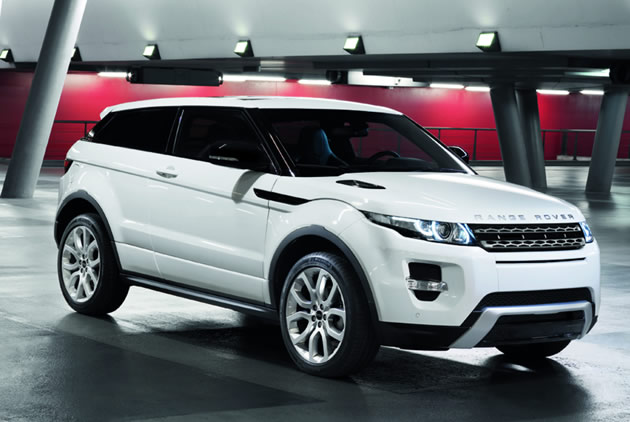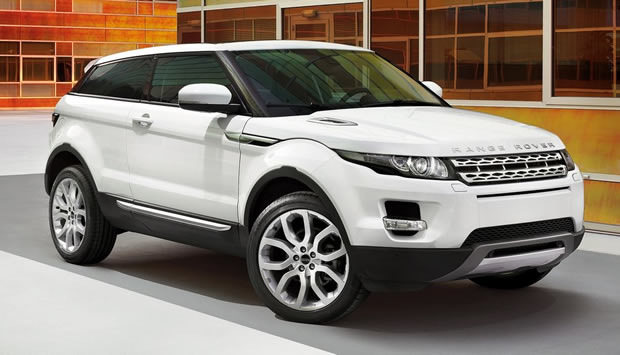 The Range Rover Evoque is a compact hatchback in production since 2011 from Land Rover. The production model was announced on July 1, 2010, and it is Land Rover’s first serious attempt at offering a vehicle designed to address the issue of climate change through the reduction of greenhouse gas emissions. A near production concept of the crossover SUV was unveiled at the North American International Auto Show as the Land Rover LRX in January 2008, and production began in 2011. The LRX is the most compact Land Rover to date. Its size complements a wide array of efficiency improving technologies in the form of Land Rover’s e_Terrain technologies. These include biofuel compatibility, lightweight construction materials and technologies such as the removable carbon composite roof panels, regenerative brakes, a stop-start system, and the ERAD (electric rear axle drive) parallel hybrid powertrain system. ERAD encompasses the incorporation of an electric motor into the rear axle of the vehicle. It will propel the LRX to speeds of up to 20 mph (32 km/h) before the engine is ignited by an integrated starter generator as part of the stop-start system. ERAD is designed to reduce CO2 emissions by an average of 20 percent under the NEDC test cycle but is expected to offer another 10 percent reduction in extra-urban driving situations. The system has been designed to also optimise the off-road ability of the vehicle. Land Rover aims to achieve 120 g/km CO2 emissions and fuel economy of 60 mpg-imp (4.7 L/100 km; 50 mpg-US) on the European combined cycle. Achieving this is an efficient 2.0 litre turbodiesel engine. It is the only four-cylinder vehicle in the Range Rover lineup. The LRX also boasts the latest incarnation of Land Rover’s acclaimed Terrain Response system offering a range of new and existing modes. These include general driving; grass/gravel/snow; sand; and new to the LRX are sports and eco modes. Typical Land Rover design traits designed to improve off-road performance and practicality include the command driving position, hill descent control and good approach and departure angles. A Land Rover first is the air intake being integrated into the roof to offer exceptional wading capabilities. The Range Rover DNA is visually apparent in the form of the clamshell bonnet, the ‘floating’ roof, the dual-pocket headlamps, and, borrowed from the Range Rover Sport, the raked roofline.
The Range Rover Evoque is a compact hatchback in production since 2011 from Land Rover. The production model was announced on July 1, 2010, and it is Land Rover’s first serious attempt at offering a vehicle designed to address the issue of climate change through the reduction of greenhouse gas emissions. A near production concept of the crossover SUV was unveiled at the North American International Auto Show as the Land Rover LRX in January 2008, and production began in 2011. The LRX is the most compact Land Rover to date. Its size complements a wide array of efficiency improving technologies in the form of Land Rover’s e_Terrain technologies. These include biofuel compatibility, lightweight construction materials and technologies such as the removable carbon composite roof panels, regenerative brakes, a stop-start system, and the ERAD (electric rear axle drive) parallel hybrid powertrain system. ERAD encompasses the incorporation of an electric motor into the rear axle of the vehicle. It will propel the LRX to speeds of up to 20 mph (32 km/h) before the engine is ignited by an integrated starter generator as part of the stop-start system. ERAD is designed to reduce CO2 emissions by an average of 20 percent under the NEDC test cycle but is expected to offer another 10 percent reduction in extra-urban driving situations. The system has been designed to also optimise the off-road ability of the vehicle. Land Rover aims to achieve 120 g/km CO2 emissions and fuel economy of 60 mpg-imp (4.7 L/100 km; 50 mpg-US) on the European combined cycle. Achieving this is an efficient 2.0 litre turbodiesel engine. It is the only four-cylinder vehicle in the Range Rover lineup. The LRX also boasts the latest incarnation of Land Rover’s acclaimed Terrain Response system offering a range of new and existing modes. These include general driving; grass/gravel/snow; sand; and new to the LRX are sports and eco modes. Typical Land Rover design traits designed to improve off-road performance and practicality include the command driving position, hill descent control and good approach and departure angles. A Land Rover first is the air intake being integrated into the roof to offer exceptional wading capabilities. The Range Rover DNA is visually apparent in the form of the clamshell bonnet, the ‘floating’ roof, the dual-pocket headlamps, and, borrowed from the Range Rover Sport, the raked roofline.Sunday, July 24, 2011
Land Rover Evoque
 The Range Rover Evoque is a compact hatchback in production since 2011 from Land Rover. The production model was announced on July 1, 2010, and it is Land Rover’s first serious attempt at offering a vehicle designed to address the issue of climate change through the reduction of greenhouse gas emissions. A near production concept of the crossover SUV was unveiled at the North American International Auto Show as the Land Rover LRX in January 2008, and production began in 2011. The LRX is the most compact Land Rover to date. Its size complements a wide array of efficiency improving technologies in the form of Land Rover’s e_Terrain technologies. These include biofuel compatibility, lightweight construction materials and technologies such as the removable carbon composite roof panels, regenerative brakes, a stop-start system, and the ERAD (electric rear axle drive) parallel hybrid powertrain system. ERAD encompasses the incorporation of an electric motor into the rear axle of the vehicle. It will propel the LRX to speeds of up to 20 mph (32 km/h) before the engine is ignited by an integrated starter generator as part of the stop-start system. ERAD is designed to reduce CO2 emissions by an average of 20 percent under the NEDC test cycle but is expected to offer another 10 percent reduction in extra-urban driving situations. The system has been designed to also optimise the off-road ability of the vehicle. Land Rover aims to achieve 120 g/km CO2 emissions and fuel economy of 60 mpg-imp (4.7 L/100 km; 50 mpg-US) on the European combined cycle. Achieving this is an efficient 2.0 litre turbodiesel engine. It is the only four-cylinder vehicle in the Range Rover lineup. The LRX also boasts the latest incarnation of Land Rover’s acclaimed Terrain Response system offering a range of new and existing modes. These include general driving; grass/gravel/snow; sand; and new to the LRX are sports and eco modes. Typical Land Rover design traits designed to improve off-road performance and practicality include the command driving position, hill descent control and good approach and departure angles. A Land Rover first is the air intake being integrated into the roof to offer exceptional wading capabilities. The Range Rover DNA is visually apparent in the form of the clamshell bonnet, the ‘floating’ roof, the dual-pocket headlamps, and, borrowed from the Range Rover Sport, the raked roofline.
The Range Rover Evoque is a compact hatchback in production since 2011 from Land Rover. The production model was announced on July 1, 2010, and it is Land Rover’s first serious attempt at offering a vehicle designed to address the issue of climate change through the reduction of greenhouse gas emissions. A near production concept of the crossover SUV was unveiled at the North American International Auto Show as the Land Rover LRX in January 2008, and production began in 2011. The LRX is the most compact Land Rover to date. Its size complements a wide array of efficiency improving technologies in the form of Land Rover’s e_Terrain technologies. These include biofuel compatibility, lightweight construction materials and technologies such as the removable carbon composite roof panels, regenerative brakes, a stop-start system, and the ERAD (electric rear axle drive) parallel hybrid powertrain system. ERAD encompasses the incorporation of an electric motor into the rear axle of the vehicle. It will propel the LRX to speeds of up to 20 mph (32 km/h) before the engine is ignited by an integrated starter generator as part of the stop-start system. ERAD is designed to reduce CO2 emissions by an average of 20 percent under the NEDC test cycle but is expected to offer another 10 percent reduction in extra-urban driving situations. The system has been designed to also optimise the off-road ability of the vehicle. Land Rover aims to achieve 120 g/km CO2 emissions and fuel economy of 60 mpg-imp (4.7 L/100 km; 50 mpg-US) on the European combined cycle. Achieving this is an efficient 2.0 litre turbodiesel engine. It is the only four-cylinder vehicle in the Range Rover lineup. The LRX also boasts the latest incarnation of Land Rover’s acclaimed Terrain Response system offering a range of new and existing modes. These include general driving; grass/gravel/snow; sand; and new to the LRX are sports and eco modes. Typical Land Rover design traits designed to improve off-road performance and practicality include the command driving position, hill descent control and good approach and departure angles. A Land Rover first is the air intake being integrated into the roof to offer exceptional wading capabilities. The Range Rover DNA is visually apparent in the form of the clamshell bonnet, the ‘floating’ roof, the dual-pocket headlamps, and, borrowed from the Range Rover Sport, the raked roofline.
Subscribe to:
Post Comments (Atom)




No comments:
Post a Comment